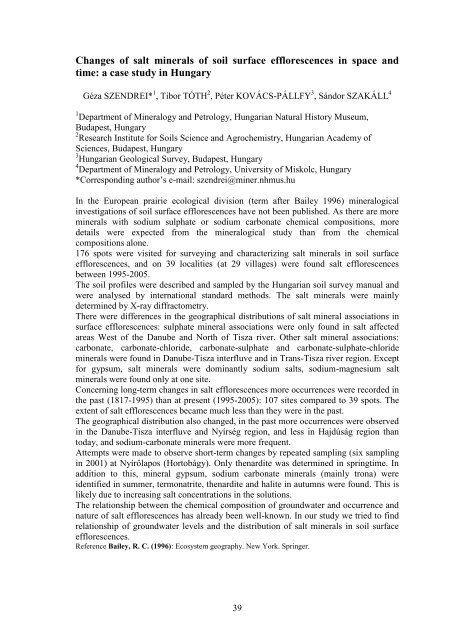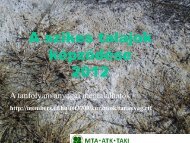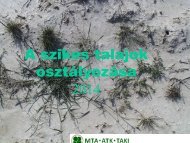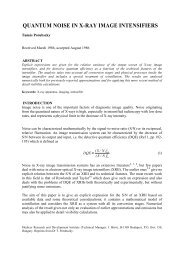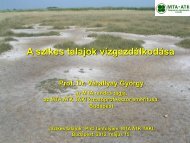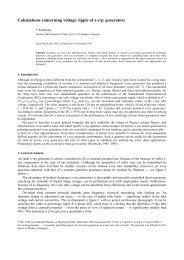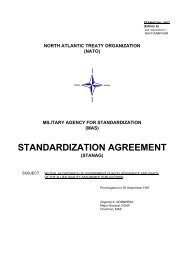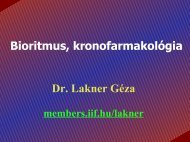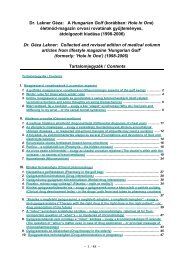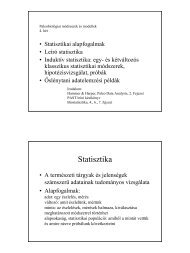Abstract form
Abstract form
Abstract form
You also want an ePaper? Increase the reach of your titles
YUMPU automatically turns print PDFs into web optimized ePapers that Google loves.
Changes of salt minerals of soil surface efflorescences in space and<br />
time: a case study in Hungary<br />
Géza SZENDREI* 1 , Tibor TÓTH 2 , Péter KOVÁCS-PÁLLFY 3 , Sándor SZAKÁLL 4<br />
1 Department of Mineralogy and Petrology, Hungarian Natural History Museum,<br />
Budapest, Hungary<br />
2 Research Institute for Soils Science and Agrochemistry, Hungarian Academy of<br />
Sciences, Budapest, Hungary<br />
3 Hungarian Geological Survey, Budapest, Hungary<br />
4 Department of Mineralogy and Petrology, University of Miskolc, Hungary<br />
*Corresponding author’s e-mail: szendrei@miner.nhmus.hu<br />
In the European prairie ecological division (term after Bailey 1996) mineralogical<br />
investigations of soil surface efflorescences have not been published. As there are more<br />
minerals with sodium sulphate or sodium carbonate chemical compositions, more<br />
details were expected from the mineralogical study than from the chemical<br />
compositions alone.<br />
176 spots were visited for surveying and characterizing salt minerals in soil surface<br />
efflorescences, and on 39 localities (at 29 villages) were found salt efflorescences<br />
between 1995-2005.<br />
The soil profiles were described and sampled by the Hungarian soil survey manual and<br />
were analysed by international standard methods. The salt minerals were mainly<br />
determined by X-ray diffractometry.<br />
There were differences in the geographical distributions of salt mineral associations in<br />
surface efflorescences: sulphate mineral associations were only found in salt affected<br />
areas West of the Danube and North of Tisza river. Other salt mineral associations:<br />
carbonate, carbonate-chloride, carbonate-sulphate and carbonate-sulphate-chloride<br />
minerals were found in Danube-Tisza interfluve and in Trans-Tisza river region. Except<br />
for gypsum, salt minerals were dominantly sodium salts, sodium-magnesium salt<br />
minerals were found only at one site.<br />
Concerning long-term changes in salt efflorescences more occurrences were recorded in<br />
the past (1817-1995) than at present (1995-2005): 107 sites compared to 39 spots. The<br />
extent of salt efflorescences became much less than they were in the past.<br />
The geographical distribution also changed, in the past more occurrences were observed<br />
in the Danube-Tisza interfluve and Nyírség region, and less in Hajdúság region than<br />
today, and sodium-carbonate minerals were more frequent.<br />
Attempts were made to observe short-term changes by repeated sampling (six sampling<br />
in 2001) at Nyírőlapos (Hortobágy). Only thenardite was determined in springtime. In<br />
addition to this, mineral gypsum, sodium carbonate minerals (mainly trona) were<br />
identified in summer, termonatrite, thenardite and halite in autumns were found. This is<br />
likely due to increasing salt concentrations in the solutions.<br />
The relationship between the chemical composition of groundwater and occurrence and<br />
nature of salt efflorescences has already been well-known. In our study we tried to find<br />
relationship of groundwater levels and the distribution of salt minerals in soil surface<br />
efflorescences.<br />
Reference Bailey, R. C. (1996): Ecosystem geography. New York. Springer.<br />
39


